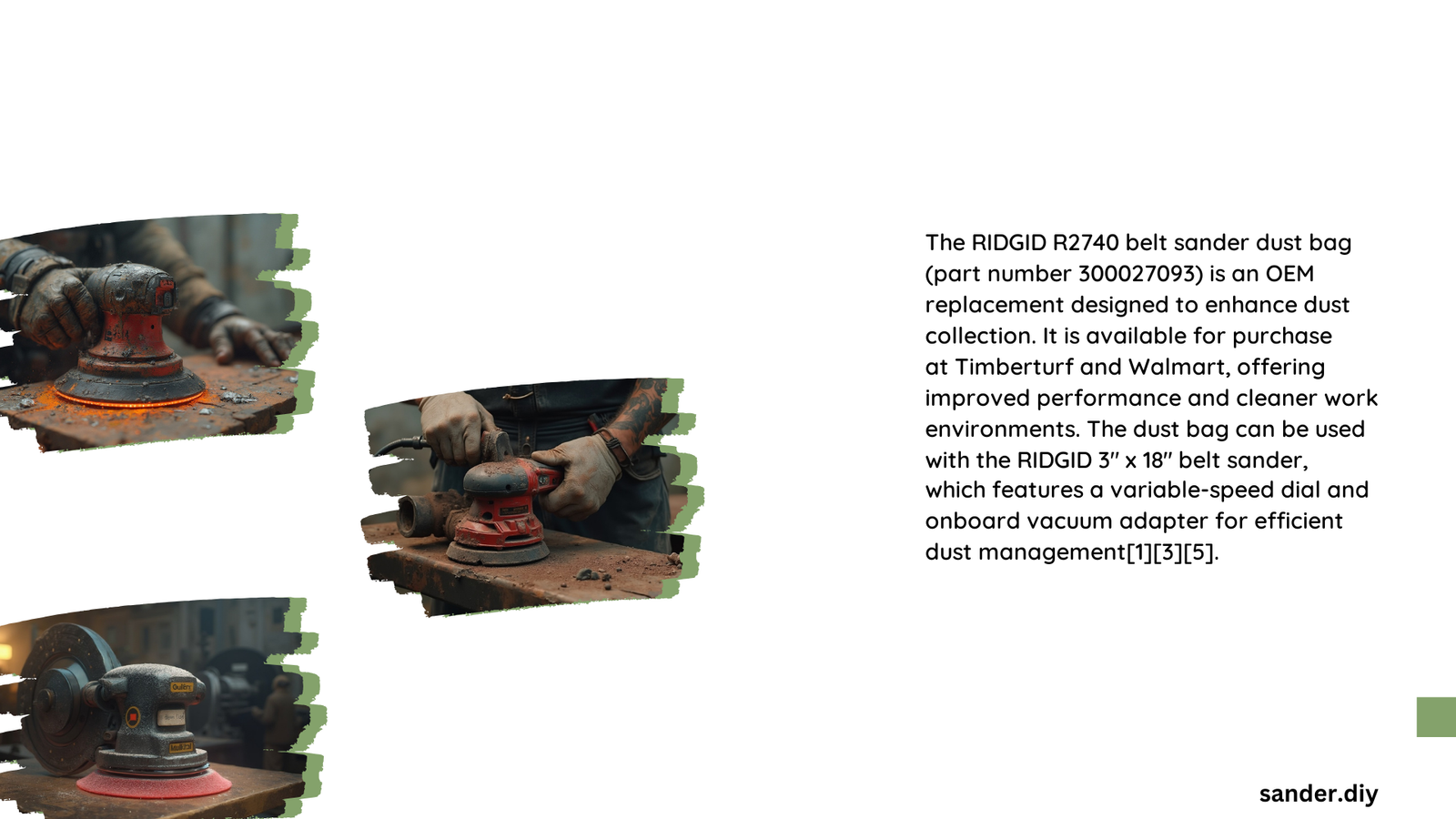The Ridgid belt sander dust bag is a crucial component for maintaining a clean work environment while using Ridgid belt sanders. These dust bags are designed to efficiently collect up to 90% of dust generated during sanding operations. Compatible with various Ridgid belt sander models, these bags are typically made of durable fabric or plastic material and are easy to install. The dust collection system, including the bag, is part of Ridgid’s Airguard technology, ensuring a cleaner work surface and improved air quality in your workspace.
What Are the Key Features of Ridgid Belt Sander Dust Bags?
Ridgid belt sander dust bags are designed with several important features:
- High Dust Collection Efficiency: The bags can collect up to 90% of dust generated during sanding.
- Durable Material: Typically made of sturdy fabric or plastic to withstand frequent use.
- Easy Installation: Most bags can be attached quickly without the need for tools.
- Model-Specific Design: Bags are tailored to fit specific Ridgid belt sander models.
- Part of Airguard Technology: Integrated into Ridgid’s dust management system for improved air quality.
How Do You Choose the Right Dust Bag for Your Ridgid Belt Sander?

Selecting the appropriate dust bag for your Ridgid belt sander is crucial for optimal performance. Here are some factors to consider:
- Sander Model Compatibility: Ensure the dust bag is compatible with your specific Ridgid belt sander model.
- Dust Port Size: Match the bag to your sander’s dust port size (e.g., 1.5 inches for R86065B model).
- Material Quality: Look for durable materials that can withstand frequent use and provide efficient dust collection.
- Replacement Part Number: Use the correct replacement part number when ordering (e.g., 300027058 for R2740 model).
What Is the Installation Process for Ridgid Belt Sander Dust Bags?
Installing a Ridgid belt sander dust bag is generally a straightforward process:
- Align the Dust Bag: Position the bag with the sander’s dust port.
- Secure the Attachment: Use the provided clip or elastic band to fasten the bag to the port.
- Check for Proper Fit: Ensure there are no gaps that could reduce dust collection efficiency.
- Verify Clearance: Make sure the bag doesn’t interfere with the sander’s operation.
The installation process typically takes only a few minutes and doesn’t require any special tools.
What Are the Compatibility Options for Ridgid Belt Sander Dust Bags?
Compatibility is a crucial factor when choosing a dust bag for your Ridgid belt sander. Here’s a compatibility chart based on available information:
| Model Number | Replacement Part Number | Dust Port Size | Compatibility Notes |
|---|---|---|---|
| R86065B | Not specified | 1.5 inches | Compatible with R86065B model |
| R2740 | 300027058 | 1-1/4 inches | Uses standard 1-1/4 inch hose |
| General | Varies | Model-dependent | Ensure dust bag matches the specific sander model’s port size |
Always verify the compatibility of the dust bag with your specific Ridgid belt sander model before purchasing.
How Much Do Ridgid Belt Sander Dust Bags Cost?
The cost of Ridgid belt sander dust bags can vary depending on the model and where you purchase them. Here’s a general price guide:
- R2740 Model: Genuine OEM replacement dust bags typically cost between $10 and $20.
- Other Models: Prices may vary, but generally fall within a similar range.
Factors that can affect the price include:
- Brand: Genuine Ridgid parts may cost more than third-party alternatives.
- Material Quality: Higher quality materials often come with a higher price tag.
- Bulk Purchasing: Buying in bulk may offer some cost savings, though specific bulk pricing information is not readily available.
How Does Cost Correlate with Efficiency and Longevity?
When it comes to Ridgid belt sander dust bags, there’s often a correlation between cost, efficiency, and longevity:
- Higher Cost = Better Quality: More expensive bags are typically made from higher-quality materials, which can lead to better dust collection efficiency and longer lifespan.
- Efficiency: Premium dust bags, like those used in Ridgid’s Airguard technology, can collect up to 90% of dust, justifying a higher price point.
- Durability: Pricier bags often use more robust materials, potentially lasting longer and providing better value over time.
- Brand Reliability: Genuine Ridgid parts, while potentially more expensive, are designed specifically for optimal performance with Ridgid sanders.
What Are the Benefits of Using Genuine Ridgid Belt Sander Dust Bags?
Opting for genuine Ridgid belt sander dust bags offers several advantages:
- Guaranteed Compatibility: Designed specifically for Ridgid sanders, ensuring a perfect fit.
- Optimal Performance: Engineered to work seamlessly with Ridgid’s Airguard technology.
- Consistent Quality: Manufactured to meet Ridgid’s quality standards.
- Warranty Compliance: Using genuine parts may be necessary to maintain warranty coverage.
- Efficient Dust Collection: Designed to capture up to 90% of dust, maintaining a cleaner work environment.
How Can You Maintain Your Ridgid Belt Sander Dust Bag?
Proper maintenance of your Ridgid belt sander dust bag can extend its lifespan and maintain its efficiency:
- Regular Emptying: Empty the dust bag when it’s about 2/3 full to maintain optimal suction.
- Cleaning: Gently clean the bag with compressed air or a soft brush to remove embedded particles.
- Inspection: Regularly check for tears or wear and replace if necessary.
- Proper Storage: Store the sander with the dust bag attached in a dry place to prevent moisture damage.
- Avoid Overfilling: Overfilled bags can reduce suction and potentially damage the sander.
By following these maintenance tips, you can ensure your Ridgid belt sander dust bag continues to perform effectively, maintaining a clean work environment and protecting your sander.
